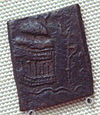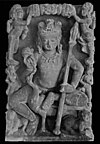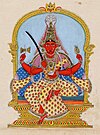ہندو مت کے معبود
| سلسلہ مضامین ہندو مت |
| ہندو مت |
|---|
 |
|
|
|
عبادات |
|

ہندو مت کے معبود (انگریزی: Hindu deities)میں ہندو مت کی دیوی اور دیوتا شامل ہیں۔ ہندو مت میں دیویوں اور دیوتاوں کے لیے مختلف نام ملتے ہیں جیسے دیو، دیوی، ایشور، ایشوری، بھگوان اور بھگوتی۔[1][2][note 1] ہندو مت کے معبودوں کا پہلا تصور ویدیک دور میں ملتا ہے اور یہ تقریباً 2 ملینیم قبل مسیح کا زمانہ ہے۔ ہندو مت کے معبود 2 ملینیم قبل مسیح سے لے کر 1 ملینیم عیسوی کے درمیان میں وقوع پزیر ہوئے ہیں۔ یہ [[نیپال]، بھارت، جنوب مشرقی ایشیا اور ہندو مت کے دیگر علاقوں میں ظاہر ہوئے۔[3][4] ہندو مت کے معبود ہندو فلسفہ کے یوگا کے ذاتی خدا،[5][6] وید کے 33 معبود [7] اور پران کے سیکڑوں خداوں پر مشتمل ہیں۔[8] پاروتی، وشنو، لکشمی، شیو، ستی (دیوی)، برہما اور سرسوتی چند اہم مشہور اور عظیم معبود ہیں جن کی تفصیل ہمیں جا بجا ملتی ہیں۔ یہ تمام معبود اپنی الگ منفرد خصوصیات اور ذاتی پہچان رکھتی ہیں مگر یہ سب کسی نا کسی طرح ایک ذات کے منسلک ہیں اور وہ برہم ہے۔[9][note 2] پہلی ملنیم سے ہی ان میں آپسی برابری کا احساس دیکھا جاتا ہے اور ہری ہر (نصف شیو نصف وشنو)[10] اور اردھنریشور (نصف شیو نصف پاروتی)[11] کا تصور پایا جاتا ہے اور ان کے مندر اور عقائد انھیں یکساں ماننے کی طرف راغب کرتے ہیں۔[12][13][14] بڑے معبودوں میں ہندو مت میں خود اپنا طریقہ عبادت جاری کیا جیسے ویشنو مت، شیو مت اور شکتی مت مگر ان کی دیومالائی کہانیاں، عقائد، علم الاقدار، مذہبی آثار، متعدد مصادر اور تھیوسفی میں کافی یکسانی پائی جاتی ہے۔[15][16][17]
عظیم ہندو معبود[ترمیم]
| نام | دیگر نام | اوتار یا متعلقہ معبود | علاقہ یا خطہ | تصویر | ابتدائی دور کی تصویر |
|---|---|---|---|---|---|
| وشنو | نارائن، Venkateshwara، جگن ناتھa دتاتریہ |
متسیہ، کورم، وراہ، نرسنگھ، وامن، پرشو رام، رام، کرشن، کلکی، Vithoba، Gopāl, بلرام، Lady موہنی، Naraenten (那羅延天، Japan) | India, Nepal, Sri Lanka | فائل:Bhagavan Vishnu.jpg | 2nd-century BC |
| شیو | Mahādeva, پشوپتی، Tripurantaka، Vishwanatha, Dakshinamurthy، Kālāntaka، Bhairava، رودر، نٹراج، Sadashiva دتاتریہ |
Achalanatha (Japan)[18][19] | India, Nepal, Sri Lanka | 
|
 1st-century BC[20] |
| برہما | Prajāpati, دتاتریہ | Bonten (Japan)،[21] Phra Phrom (Thailand) |
India, Nepal, Sri Lanka, Southeast Asia | 
|
 6th-century AD |
| گنیش | Ganapati, Vināyaka، Lambodara, Gajānana | Kangiten (Japan) | India, Nepal, Sri Lanka | 
|
 7th-century AD |
| کارتیکے | Skanda, Murugan | India, Sri Lanka, Malaysia | 
|
 2nd-century BC | |
| پاروتی | Uma, دیوی (ہندومت)، Gauri, درگا، کالی، ان پورنا دیوی |
Umahi (烏摩妃، Japan) Dewi Sri (Indonesia)[22] |
India, Nepal, Sri Lanka | 
|
 5th-century AD |
| لکشمی | Sri Devi، Gajalakshmi، Kamalāsanā | Sita, Rādhā، Kisshōten (Japan) Nang Kwak (Thailand)[23] |
India, Nepal, Sri Lanka | 
|
 1st-century BC |
| سرسوتی | Vāgishvari, Vīnāpāni | Benzaiten (Japan)، Biàncáitiān (China)، Thurathadi (میانمار)، Suratsawadi (Thailand)[24] |
India, Nepal, Java, Bali, Sri Lanka | 
|
 10th-century AD |
| درگا | پاروتی، کالی، درگا |
Betari Durga (انڈونیشیا)[25] | India, Nepal, Sri Lanka | 
|
 8th-century AD |
| کالی | درگا، پاروتی | India, Nepal, Sri Lanka | 
|
 12th-century AD | |
| مری امن | درگا، پاروتی | India (mostly in South India)، Southeast Asia, Sri Lanka |

|
 10th-century AD | |
| ہری ہر (Half Vishnu – Half Shiva) | India, Sri Lanka | 
|
 6th-century AD | ||
| Ardhanārīshvara (Half Shiva – Half Parvati) | India, Nepal, Sri Lanka | 
|
 1st-century AD |
حواشی[ترمیم]
- ↑ For translation of deva in singular noun form as "a deity, god"، and in plural form as "the gods" or "the heavenly or shining ones"، see: Monier-Williams 2001, p. 492 and Renou 1964, p. 55
- ↑ [a] Lisa Hark، Horace DeLisser (2011)۔ Achieving Cultural Competency۔ John Wiley & Sons۔
Three gods, Brahma, Vishnu, and Shiva, and other deities are considered manifestations of and are worshipped as incarnations of Brahman.
[b] Toropov & Buckles 2011: The members of various Hindu sects worship a dizzying number of specific deities and follow innumerable rites in honor of specific gods. Because this is Hinduism, however, its practitioners see the profusion of forms and practices as expressions of the same unchanging reality. The panoply of deities are understood by believers as symbols for a single transcendent reality.
[d] Orlando O. Espín, James B. Nickoloff (2007)۔ An Introductory Dictionary of Theology and Religious Studies۔ Liturgical Press۔While Hindus believe in many devas, many are monotheistic to the extent that they will recognise only one Supreme Being, a God or Goddess who is the source and ruler of the devas.
حوالہ جات[ترمیم]
- ↑ Radhakrishnan and Moore (1967, Reprinted 1989)، A Source Book in Indian Philosophy, Princeton University Press, آئی ایس بی این 978-0691019581، pages 37-39, 401-403, 498-503
- ↑
- ↑ Nicholas Gier (2000)، Spiritual Titanism: Indian, Chinese, and Western Perspectives, State University of New York Press, آئی ایس بی این 978-0791445280، pages 59-76
- ↑ Jeaneane D. Fowler (2012)، The Bhagavad Gita, Sussex Academic Press, آئی ایس بی این 978-1845193461، pages 253-262
- ↑ Renou 1964, p. 55
- ↑ Mike Burley (2012)، Classical Samkhya and Yoga – An Indian Metaphysics of Experience, Routledge, آئی ایس بی این 978-0415648875، page 39-41;
Lloyd Pflueger، Person Purity and Power in Yogasutra, in Theory and Practice of Yoga (Editor: Knut Jacobsen)، Motilal Banarsidass, آئی ایس بی این 978-8120832329، pages 38-39;
Kovoor T. Behanan (2002)، Yoga: Its Scientific Basis, Dover, آئی ایس بی این 978-0486417929، pages 56-58 - ↑ George Williams (2008)، A Handbook of Hindu Mythology, Oxford University Press, آئی ایس بی این 978-0195332612، pages 90, 112
- ↑ Sanjukta Gupta (2013)، Lakṣmī Tantra: A Pāñcarātra Text, Motilal Banarsidass, آئی ایس بی این 978-8120817357، page 166
- ↑ Knut Jacobsen (2008)، Theory and Practice of Yoga : 'Essays in Honour of Gerald James Larson, Motilal Banarsidass, آئی ایس بی این 978-8120832329، pages 77-78
- ↑ David Leeming (2001)، A Dictionary of Asian Mythology، Oxford University Press, آئی ایس بی این 978-0195120530، page 67
- ↑ Ellen Goldberg (2002)، The Lord who is half woman: Ardhanārīśvara in Indian and feminist perspective، State University of New York Press, آئی ایس بی این 0-791453251، pages 1–4
- ↑ TA Gopinatha Rao (1993)، Elements of Hindu Iconography، Vol. 2, Motilal Banarsidass, آئی ایس بی این 978-8120808775، pages 334-335
- ↑ Fred Kleiner (2012)، Gardner's Art through the Ages: A Global History, Cengage, آئی ایس بی این 978-0495915423، pages 443-444
- ↑ Cynthia Packert Atherton (1997)، The Sculpture of Early Medieval Rajasthan, Brill, آئی ایس بی این 978-9004107892، pages 42-46
- ↑ Lance Nelson (2007)، An Introductory Dictionary of Theology and Religious Studies (Editors: Orlando O. Espín, James B. Nickoloff)، Liturgical Press, آئی ایس بی این 978-0814658567، pages 562-563
- ↑ Julius J. Lipner (2009)، Hindus: Their Religious Beliefs and Practices, 2nd Edition, Routledge, آئی ایس بی این 978-0-415-45677-7، pages 371-375
- ↑ Jessica Frazier (2011)۔ The Continuum Companion to Hindu Studies۔ London: Continuum۔ صفحہ: 1–15۔ ISBN 978-0-8264-9966-0
- ↑ Jiro Takei and Marc P Keane (2001)، SAKUTEIKI, Tuttle, آئی ایس بی این 978-0804832946، page 101
- ↑ Miyeko Murase (1975)، Japanese Art: Selections from the Mary and Jackson Burke Collection, The Metropolitan Museum of Art (New York)، آئی ایس بی این 978-0870991363، page 31
- ↑ M Chakravarti (1995)، The concept of Rudra-Śiva through the ages, Motilal Banarsidass, آئی ایس بی این 978-8120800533، pages 148-149
- ↑ Robert Paine and Alexander Soper (1992)، The Art and Architecture of Japan, Yale University Press, آئی ایس بی این 978-0300053333، page 60
- ↑ Joe Cribb (1999)، Magic Coins of Java, Bali and the Malay Peninsula, British Museum Press, آئی ایس بی این 978-0714108810، page 77
- ↑ Jonathan Lee, Fumitaka Matsuoka et al (2015)، Asian American Religious Cultures, ABC, آئی ایس بی این 978-1598843309، page 892
- ↑ Kinsley, David (1988)، Hindu Goddesses: Vision of the Divine Feminine in the Hindu Religious Traditions, University of California Press, آئی ایس بی این 0-520-06339-2، pages 94-97
- ↑ Francine Brinkgreve (1997)، Offerings to Durga and Pretiwi in Bali، Asian Folklore Studies Vol. 56, No. 2, pages 227-251
بیرونی روابط[ترمیم]
| ویکی ذخائر پر ہندو مت کے معبود سے متعلق سمعی و بصری مواد ملاحظہ کریں۔ |
- A chart of the main Hindu deities (with pictures)


